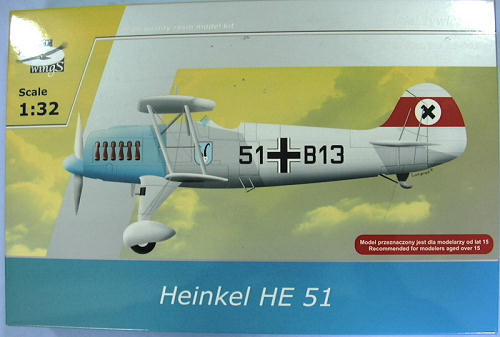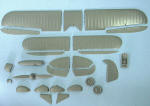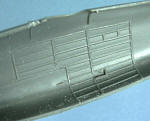Silver Wings 1/32 He-51
|
KIT #: |
32-001 |
|
PRICE: |
$? |
|
DECALS: |
Two options |
|
REVIEWER: |
Tom Cleaver |
|
NOTES: |
Resin kit |

There is a saying in aviation design that, "if it looks right, it is
right." While this is generally
true, it was unfortunately not the case as regards the Heinkel He-51, which was
a completely orthodox biplane of undistinguished performance, though this was
due to the failure of the German aircraft industry of the period to develop
suitable high-performance engines as was happening in Great Britain at
Rolls-Royce. Had the He-51 been
powered by a Kestrel, like its contemporary the Hawker Fury, things might have
been different, even if it was nowhere near as maneuverable as that famous
classic.
What was important about the He-51 from a design standpoint was its
elegance of line, being the first design to come from the aesthetic of designer
Walter Gunter; complemented by the mathematic genius of his twin brother
Siegfried, these two would provide the indelible hallmark "look" of Heinkel
aircraft of the Thirties.
The airplane first appeared as the He-51a.
The Technischen Amt of the Luftfahrtkommisariat became
interested when it was revealed it had a higher performance than the Arado
Ar-65E which was planned as the first fighter equipment of the still-secret
Luftwaffe, with the same BMW 6.0 ZU engine; this fighter promised performance
that would equal the international standard.
Introduced into service as the He-51A-0, the fighter equipped the DVL
Reklame-Staffel Mitteldeutschland, the "Central
Germany
Publicity Squadron," which would later become known as II/JG.132 "Richtofen"
when the Luftwaffe was revealed to the rest of
Europe
in 1935. Early accidents were laid
to deficiencies in training rather than anything intrinsic to the design.
The He-51B differed from its predecessor in having twin-wire bracing of
the landing gear, and the ability to carry a 50-liter drop tank beneath the
fuselage. As production
proliferated in 1936-37, so did the number of Jagdgeschwader mounted on
the elegant-looking fighter, with their colorful unit markings.
The beginning of the end for the He-51 came in January 1936.
The Luftwaffefuhrungsstab considered that the Arado Ar-68 offered
little over the Heinkel in terms of performance and questioned putting it into
production. Ernst Udet, Inspector of Fighter and Dive Bomber Pilots, decided to
resolve the question. Mounted in
the Ar-68E, with a very experienced pilot in an He-51, Udet out-climbed,
out-dove and out-maneuvered the Heinkel fighter with ease.
Later that year, in response to requests from General Francisco Franco,
Hitler decided to provide support to the Nationalists in what was developing
into the Spanish Civil War. Six
He-51s were sent to
Spain
with six German pilots to instruct Spanish pilots.
Unfortunately, the airplane was a "handful" for the Spanish, who
immediately wrote off two of them.
The Germans entered combat unofficially and met with such success that it was
decided a "volunteer" fighter squadron would be seconded to the Spanish, to
allow Luftwaffe pilots to gain invaluable combat experience. At about the
same time, Polikarpov I-15s flown by Soviet "volunteers" appeared on the side of
the Republicans. When the two
fighters met, it was no contest as to which was the better: the "Chato" could
fly rings around the Heinkel, as well as outgun it, and the He-51s were reduced
to targets, unfit to take part in aerial combat.
The He-51 became a ground attack fighter for the remainder of its service
in
Spain,
and was replaced in Luftwaffe service as rapidly as possible. However, the units
flying the He-51 in ground support did develop the tactics later used by the
Schlachtflieger units in the Second World War.
In retrospect, the failure of the He-51 when it entered combat was
ultimately a good thing for the Luftwaffe, since it forced the service to
bring the Messerschmitt Bf-109 into operational use far earlier than would
otherwise have been the case, subjecting that great design to the pressure of
wartime development from the beginning of its career, and assuring it of the
ascendancy it would hold when war finally broke out in Europe three years later.
As well, the early introduction of the Bf-109 into combat forced the pilots of
the Luftwaffe to abandon the useless formations and tactics of the
biplane era, and create tactics and formations appropriate to a high-speed
fighter; this would mean they could outfly their enemies for at least the first
two years of the Second World War, since their opponents still used the outmoded
tactics.
 The He-51 first appeared as a kit in the early 1970s, when Hasegawa
released their 1/72 model; this can still be found, and it makes up into a very
nice model with a bit of work to create a cockpit interior.
In 1996, Classic Airframes released their first kit of the He-51, a
limited-run kit to be followed in 2008 by a later release featuring better
molding technology. This He-51 from
Silver Wings is the first kit of this airplane in 1/32 scale.
The He-51 first appeared as a kit in the early 1970s, when Hasegawa
released their 1/72 model; this can still be found, and it makes up into a very
nice model with a bit of work to create a cockpit interior.
In 1996, Classic Airframes released their first kit of the He-51, a
limited-run kit to be followed in 2008 by a later release featuring better
molding technology. This He-51 from
Silver Wings is the first kit of this airplane in 1/32 scale.
The kit is all resin, and is of the highest quality.
Wojciech Kulakowski is the designer of the Montex Fury Mk.I, the Hs-123
and the Yak-1b, which are among the very best all-resin kits released and are
the best kits of these aircraft available in any scale.
With the release of this He-51, he has outdone himself.
The fuselage halves are molded so thin, and the other parts are of such
quality, that you could easily mistake the
 kit
for an injection-molded kit from a mainstream company like Hasegawa or Tamiya.
kit
for an injection-molded kit from a mainstream company like Hasegawa or Tamiya.
The cockpit is fully detailed, and lacks only seat belts, a problem
easily solved by the use of Eduard’s 1/32 photoetch Luftwaffe seatbelts. The
surface detail is crisp and subtle.
All control surfaces are separate, so the model can be posed dynamically.
Fit of the parts is as good as I found in the Montex Yak-1b (surprise
surprise) and there do not appear to be any nasty surprises awaiting the modeler
when construction begins. I
particularly like that the cabane struts and interplane struts are cast with
wire cores, which will give them strength while providing better parts than were available with the white metal struts in the Fury Mk.I kit.
parts than were available with the white metal struts in the Fury Mk.I kit.
Decals are provided for a He-51B-1 operated by 3./JG 223 at Wien-Aspern
in 1938, and an He-51B-2 operated by the Legion Condor in
Spain
in 1937. These look to be
excellent. A modeler will want to
rob a 1.32 Bf-109 decals sheet for the necessary stencils and other maintenance
markings.
Despite its lack of performance, the He-51 is definitely one of the
best-looking biplane fighters ever made, and it epitomizes the early Luftwaffe.
The kit is a must-have for the serious modeler who is a fan of biplanes,
fighters of the 1930s, or the Luftwaffe (or all three!).
The kit does not look like it will present any problems for an
experienced modeler who has done both a few biplanes and a few all-resin kits.
With the kind of detail that is here,
the kit is well worth its admittedly-expensive price, since “it’s all up there
on the screen.” Highly recommended.
This one goes to the top of the to-do pile.
Thanks to
Wojciech Kulakowski at Silver Wings for the review kit.
For more information, including a price quote, contact Silver Wings at:
silverwings@silverwings.pl
Tom Cleaver
June 2009
Thanks to If you would like your product reviewed fairly and quickly, please
contact
me or see other details in the
Note to
Contributors.
Back to the Main Page
Back to the Previews Index Page


 The He-51 first appeared as a kit in the early 1970s, when Hasegawa
released their 1/72 model; this can still be found, and it makes up into a very
nice model with a bit of work to create a cockpit interior.
In 1996, Classic Airframes released their first kit of the He-51, a
limited-run kit to be followed in 2008 by a later release featuring better
molding technology. This He-51 from
Silver Wings is the first kit of this airplane in 1/32 scale.
The He-51 first appeared as a kit in the early 1970s, when Hasegawa
released their 1/72 model; this can still be found, and it makes up into a very
nice model with a bit of work to create a cockpit interior.
In 1996, Classic Airframes released their first kit of the He-51, a
limited-run kit to be followed in 2008 by a later release featuring better
molding technology. This He-51 from
Silver Wings is the first kit of this airplane in 1/32 scale.
 kit
for an injection-molded kit from a mainstream company like Hasegawa or Tamiya.
kit
for an injection-molded kit from a mainstream company like Hasegawa or Tamiya.
 parts than were available with the white metal struts in the Fury Mk.I kit.
parts than were available with the white metal struts in the Fury Mk.I kit.